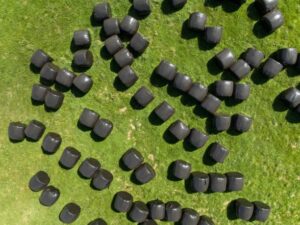Whether you are using twine, net wrap or plastic film to encase your bales, proper wrapping is important. Bales left unwrapped can spoil and degrade, reducing their nutritional value to livestock.
Drying hay as quickly as possible limits respiration losses and reduces moisture content, increasing quality and quantity. Selecting a specialized bale wrap film that matches your baling equipment is also critical.
Moisture Resistant
 When wrapping hay bales, the plastic wrap mustn’t leak. If the bales are wet inside, they may start to spoil. Using plastic to wrap hay bales keeps water and air out, and it also helps to preserve the nutrient content of the forage. In fact, studies show that hay wrapped with stretch film has less weather damage and is often better forage than unwrapped hay after a year in storage.
When wrapping hay bales, the plastic wrap mustn’t leak. If the bales are wet inside, they may start to spoil. Using plastic to wrap hay bales keeps water and air out, and it also helps to preserve the nutrient content of the forage. In fact, studies show that hay wrapped with stretch film has less weather damage and is often better forage than unwrapped hay after a year in storage.
The number of layers of the plastic wrap needed depends on the moisture content of the hay bales. Generally, the drier the hay bales are, the more layers of the film are necessary. It is because drier hay has sharper stems that can poke through the wraps, allowing moisture to move into the bale and cause spoilage.
If you are wrapping dry hay bales, use the minimum number of rotations possible to prevent holes in the plastic wrap. It is also best to store these bales in a location where they can remain undisturbed for at least 24 hours after wrapping. Attempting to move them during this time could cause them to burst from fermentation gases and expose the hay to spoilage.
Bales can be wrapped the day after they are cut if weather conditions allow it. In addition to reducing rain damage and improving weathering, this practice can save money by allowing the hay to be baled sooner. It reduces labour and equipment costs and allows producers to get more hay out of the field and into the barn.
Puncture Resistant
Keeping the bale wrap film protected with a thicker, stronger plastic is vital to keeping hay moisture low and the nutritional value high. A thin or damaged film can let moisture in and cause spoilage, which will decrease the quality of your hay. Bales wrapped with twine or net wrap tend to shed more moisture when being moved or stored, resulting in loss of hay and nutrition value. Wrapping them in plastic film helps to minimize this issue and reduces the amount of hay that is lost when baled, handled or moved.
When wrapping a round or square bale with plastic film, it is important to keep the wrap away from anything that may poke holes in the film, such as sharp stubble or poorly drained soil. It’s also a good idea to periodically check for rodent damage and replace the film if needed.
The bale wrap film is engineered to be trouble-free and perform well in all weather conditions. It is made on a co-extrusion blown film line and has five layers of raw materials that are optimized for performance, tack characteristics and oxygen barrier properties. It also has a UV additive that protects the film from damaging sun rays that can degrade LDPE over time.
Environmentally Friendly
When a farmer wraps their hay bales with plastic or net, they don’t have to worry about moisture damage to the hay. It protects the nutritional value of the hay and reduces the risk of spoilage. It is especially important for hay that’s going to be stored for longer periods.
Twine-wrapped hay tends to shed moisture into the bale during storage, which increases the risk of spoilage and decreases the quality of the hay. When a hay bale has too much moisture, microorganisms inside the hay break down proteins and create butyric acid. This acid ruins the nutritional value of the hay and makes it unsuitable for livestock consumption.
Bales wrapped with bale wrap film or net have a higher quality, which allows them to retain more of the original leaves. It protects the hay from the harsh elements of wind and sun, and it helps to keep the hay drier and more palatable for livestock.
For best results, wrap the hay bales close to where they will be stored. It will help to minimize handling and reduce the risk of damage to the plastic film. Also, the hay will start to ferment shortly after wrapping, and moving them during this process could cause the bales to burst from fermentation gases. The number of times the bales are rotated depends on the expected length of storage. However, if the rotations are too frequent, the plastic may degrade and allow oxygen to penetrate the bales.